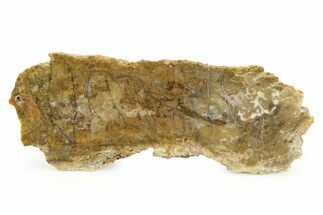This Specimen has been sold.
13" Jurassic Petrified Wood (Araucaria) Round - Utah
This is a colorful, 13" wide polished round of petrified wood from the Morrison Formation near Hanksville, Utah. One side has been polished to a glossy finish. Beautiful coloration on this specimen with several agate filled cracks. Spots of fungal rot can be seen throughout the polished face.
This beautiful round of petrified wood is Upper Jurassic in age or approximately 150 million years old. The formation which it comes from is the same formation known for producing fossils of well known dinosaurs such as Allosaurus and Diplodocus. So this tree was living at the same time as the dinosaurs!
It comes with a metal display stand.
This beautiful round of petrified wood is Upper Jurassic in age or approximately 150 million years old. The formation which it comes from is the same formation known for producing fossils of well known dinosaurs such as Allosaurus and Diplodocus. So this tree was living at the same time as the dinosaurs!
It comes with a metal display stand.
What Is Petrified Wood
Petrified wood is the name given to wood that has been turned into stone (fossilized) through the process of permineralization. In this process, all of the organic matter becomes replaced by minerals, while much of the original structure, such as tree rings, is retained. For this to happen, the wood needs to be buried in an environment low in oxygen to prevent decomposition and with flowing, mineral-laden water, so minerals may replace structures. The coloration is caused by various minerals that present in that water during fossilization. For example, red colors are due to iron compounds, greens due to copper, and so on.
Petrified wood is the name given to wood that has been turned into stone (fossilized) through the process of permineralization. In this process, all of the organic matter becomes replaced by minerals, while much of the original structure, such as tree rings, is retained. For this to happen, the wood needs to be buried in an environment low in oxygen to prevent decomposition and with flowing, mineral-laden water, so minerals may replace structures. The coloration is caused by various minerals that present in that water during fossilization. For example, red colors are due to iron compounds, greens due to copper, and so on.
SPECIES
Araucaria sp.
LOCATION
Hanksville area, Utah
FORMATION
Morrison Formation
SIZE
13 x 12", 1.05" thick
CATEGORY
SUB CATEGORY
ITEM
#246251
We guarantee the authenticity of all of our specimens.
 Reviews
Reviews











